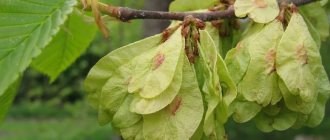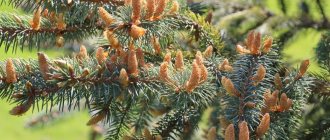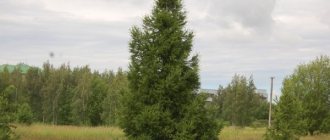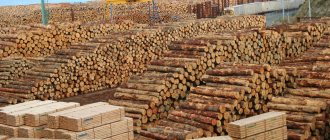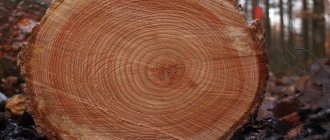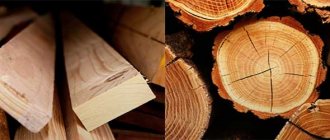a relatively hard and durable fibrous material, the main part of the trunks, branches and roots of trees and shrubs hidden by bark. It consists of countless tube-shaped cells with shells mainly of cellulose, firmly cemented with calcium and magnesium pectates into an almost homogeneous mass. In its natural form it is used as a building material and fuel, and in crushed and chemically processed form - as a raw material for the production of paper, fiber boards, and artificial fiber. Wood was one of the main factors in the development of civilization and even today remains one of the most important types of raw materials for humans, without which many industries could not do.
Also on topic:
CELLULOSE
Fir
Fir, or Douglas fir, is a very hard and durable softwood. Douglas firs grow very tall, reaching heights of 60 to 90 meters if left to their own devices in the forest. The wood is rot and insect resistant, but not as resistant as cedar.
Douglas fir has a very distinct grain and is usually quite straight. The wood is reddish-brown in color and does not take paint particularly well. Due to the grain structure and density (it is a heavy wood), nails driven into Douglas fir tend to stay in place. It's also relatively inexpensive. All of these characteristics make it an excellent choice for construction lumber, although DIYers also use it for decking and some woodworking projects.
Application. For cladding walls, ceilings and as a floor.
It is strong, durable, long, and easy to process.
Physical properties.
The relative density of wood ranges from 0.1 (balsa) to ~1.3 (ironwood and some other tropical species). The relative density of most industrial wood is 0.2–0.75, density – 190–850 kg/m3. The relative density of wood matter is approximately 1.5. Consequently, only about 1/6 of the volume of light industrial wood is solid matter, while in heavier grades it accounts for about half the volume. The relative density can be different for one tree species, which is due to the variability of growing conditions. Thus, for long-leaf pine this value can range from 0.25 to 0.80 (average value 0.53).
Both standing wood and industrial wood strongly absorb water, which is due to its capillary structure. Free water fills the cellular cavities, and bound water is retained due to adsorption in the spaces between the fibers. When all free water has been removed during drying, so that the entire vascular system is filled with bound water, the wood reaches the point of fiber saturation, which for most species corresponds to a moisture content of about 28%. Further removal of water leads to shrinkage, since when adsorbed water is desorbed, the fibers shrink and the lumen of the vessels decreases.
Depending on the presence of moisture, wood shrinks or swells. Shrinkage from the saturation point of the fibers to the state after drying in an oven is maximum (4–14%) in the tangential direction (parallel to the growth rings), approximately half as much (2–8%) in the radial direction (across the growth rings) and is practically absent (0. 1–0.2%) along the fibers. Tangential, radial and volumetric shrinkage are approximately proportional to the change in the moisture content of the wood.
The mechanical properties of wood are closely related to its fiber-cellular structure. Its strength is maximum along and quite low across the fibers. The tensile strength (per unit mass) of wood when stretched along the grain is 40 times, and when compressed, 3–4 times greater than that of steel. The compressive strength along the fibers is approximately 6 times, and the shear strength is approximately 4 times greater than across the fibers. Since compressive and bending forces are typical in structures, wood is particularly suitable for use in building structures as columns and short beams. Almost all strength properties of wood vary proportionally to density and inversely proportional to moisture content below the saturation point of the fibers. The inclination of the fibers, i.e. deviation of their direction from the longitudinal axis reduces the strength of the wooden structural element. In the same way, it decreases if there are knots in boards and logs, embedded parts of branches that disrupt or completely interrupt the flow of fibers. However, in the absence of tensile and bending loads, small knots are acceptable. The strength of wood is also reduced due to damage by putrefactive microorganisms and insects.
Red tree
If you're not familiar with the redwood tree, you may know it better by its more romanticized nickname, Sequoia. Redwood trees are known as the tallest tree species in the world, growing up to 120 meters.
Mahogany is very soft, workable and lightweight. Color varies from pale white or yellow to dark red and reddish brown. Growing as tall and fast as these giants, the grain is usually straight, and the grain of old redwood is very dense. The wood has a rough texture and is rot and insect resistant, making it an excellent choice for outdoor applications. But it is quite an expensive pleasure.
Application. Redwood is most often used to create durable decks, fences, outdoor furniture, large beams and veneers. Can be suitable for contact with the ground after pressure treatment.
Wood in construction
Since ancient times, wood has been used as a building material for the construction of walls and log houses. Although metal-plastic windows and doors have been installed recently, wooden products are still not inferior, and even superior in their properties.
And a natural wood floor will create a warm microclimate in your home. A wooden staircase will also look unsurpassed.
In the design field, wood material is used for cladding the walls of houses, saunas, and for the production of furniture.
Why do builders and designers choose a natural material - wood?
Cherry
Cherry trees aren't just good for their fruit: they also produce one of the most sought-after types of wood.
Cherry wood ranges from creamy white to red and reddish brown, and darkens as it ages and dries. The fibers are very straight and dense, which gives the cherry wood a uniform appearance and it grinds well. Once stained and sealed, cherry produces one of the smoothest surfaces available, giving it a very luxurious appearance.
Application. Thanks to its luxurious finishing qualities, cherry is popular for high-quality furniture and cabinetry, as well as for musical instruments, flooring and carvings.
cellulose acetate
As a result of the interaction of cellulose with a mixture of acetic anhydride and acetic acid, cellulose acetate esters are formed - cellulose acetate. To obtain cellulose acetate, refined wood cellulose can be used, but the main raw material so far is cotton cellulose (linter). Cellulose acetate is used to produce silk acetate, cellon (non-flammable plastic), varnishes, film and other products. Cellulose dissolves in an ammonia cupric oxide solution to form a copper-ammonia complex compound, which is used to produce very fine copper-ammonium fiber. When cellulose interacts with water in the presence of catalysts, a hydrolysis reaction occurs and the simplest sugar is formed - glucose. Mineral acids are usually used as catalysts (acid hydrolysis).
Mahogany
Mahogany is a luxury hardwood. Can grow very tall, over 50 meters.
When it comes to hardwoods for luxury finishes and projects, mahogany is second to none (even cherry wood is second to none). The wood tends to be a deep red or brownish red. Mahogany has a very smooth, dense texture and is extremely durable and elastic. It is also very dense, making it resistant to both rot and insects.
lignin
In addition to carbohydrates (cellulose and hemicelluloses), the cell membrane contains an aromatic compound - lignin, which has a high carbon content. Cellulose contains 44.4% carbon, and lignin 60-66%. Lignin is less stable than cellulose and easily goes into solution when wood is treated with hot alkalis, aqueous solutions of sulfurous acid or its acid salts. This is the basis for the production of technical cellulose. Lignin is obtained in the form of waste during the cooking of sulfite and sulfate cellulose, and during the hydrolysis of wood. The lignin contained in black alkalis is mainly burned during regeneration.
Lignin is used as pulverized fuel, a substitute for tannins, in the production of fasteners, molding lands (in the foundry industry), plastics, artificial resins, for the production of activated carbon, vanillin, etc. However, the issue of the full qualified chemical use of lignin has not yet been resolved. Of the remaining organic substances contained in wood, resins and tannins have received the greatest industrial use.
Maple
Red maple - reaches a height of 30 meters and can have extensive crowns.
The hardwood that rock maple produces is very dense and durable, with a beautiful light appearance that ranges from white, yellow to deep golden color. The fibers are relatively dense and straight, with light brown stripes. There is also figured maple, with an interesting wavy grain pattern. Both grain types produce a smooth, fine texture that looks very nice.
Application. Maple is a popular choice for flooring, plywood, paper, musical instruments, butcher's boards, workbenches and baseball bats.
Wood species and their use
Certain types of trees and their species are classified according to a number of characteristics. The most well-known division is into deciduous and coniferous species. There are species that grow on the territory of our state and other countries. From an economic and geographical point of view, this is a very important division, since the cost of imported wood may be higher than domestic wood in some cases.
Deciduous species, in turn, are divided according to their shape: ring-vascular and diffuse-vascular. And the latter can be distinguished by soft or hard wood.
Ring-vascular wood (ash, acacia, elm, oak, pistachio) received this name because the largest vessels are located closer to the center, in the early zones of the growth rings. In scattered vascular rocks (beech, hornbeam, rowan, maple), large vessels are dispersed more or less evenly. This changes the grain of the wood.
Both deciduous and coniferous trees are widely used in house building and other areas of construction technology. They are traditionally used to make such elements of building structures as walls, frames, partitions, rafters and other roofing elements. They are widely used in the manufacture of fences, porches, verandas (terraces), gazebos and a number of ancillary buildings.
Oak
Oak trees, red or white, typically grow up to 25 meters tall and drop acorns every fall.
Oak comes in two common varieties: white and red. Both are very dense and tough, with a straight-grained, rough texture. Red oak has a redder hue, while white oak is lighter, ranging from white to pale yellow. White oak is known for its “spotting,” a wavy, contrasting pattern revealed during the sawing process. Oak is rot and insect resistant, and although it is very strong, it tends to bend. It also takes paint very well, but the grain will show after a few coats.
Application. Oak's durability and flexibility make it an excellent choice for shipbuilding and wine or whiskey barrels. Oak is also commonly used for flooring, furniture and joinery.
Wood waste products
As a result of processing wood raw materials into lumber, the average yield of finished products is about 65%. The remaining 35% comes from waste in the form of slabs (14%), sawdust (12%), trimmings and small items.
In the case of processing lumber for the production of building materials, furniture and household products, about 40% of waste is obtained (sawdust, cuttings, shavings). Therefore, for a more rational use of this material, this “rejection” is also used in industry.
In particular, sawdust is used for the manufacture of thermal insulation and wall materials, which contain astringent solutions. In addition, they are one of the components of partition and finishing gypsum boards. The shavings are also used for the production of particle boards.
From small lumpy waste and scraps, shavings are obtained by crushing for the manufacture of chipboard, wood concrete, etc. Large waste is used to create glued structures for various purposes (sleepers, beams, window blocks, etc.).
Eco-products from valuable wood waste:
Teak
When it comes to combining durability and beautiful appearance, teak is one of the best options in the hardwood market.
Teak is generally a straight-grained wood with a rough and uneven grain. The wood is composed of natural oils, making it very resistant to rot and insects. Despite these oils, teak is easy to work with, both for gluing and finishing. In many ways, teak and mahogany are very similar, but teak is undeniably brown, while mahogany often has a red tint.
Application. Teak is most often used in the boat industry, furniture, carvings and other small woodwork.
Structure
Rice. 1. Main cuts of a tree trunk: P – transverse; R – radial; T – tangential.
Rice. 2. Scheme of the microscopic structure of pine wood (according to V. E. Vikhrov): 1 – annual layer; 2 – multi-row beam with a horizontal resin stroke; 3 – bordered pore; 4 – l...
D. is studied in three sections of the trunk: transverse and two longitudinal – radial and tangential (Fig. 1). In D., a distinction is made between sapwood (peripheral light zone) and core (central zone), which has a darker color in the so-called. core wood or slightly different in color from the sapwood of coreless wood. Among noncore wood species (spruce, fir, beech, etc.) mature wood species are distinguished, which have a center. the D. zone in a freshly cut state is less humid than the peripheral one, and sapwood (birch, maple) - with uniform moisture across the cross section of the trunk. Annual layers (annual growths of D.) in a cross section have a concentric appearance. circles, on the radial and tangential - straight and curved strips, respectively; at pl. rocks in each layer, a less dense light (the so-called early) and a more dense dark (late) vein is noticeable. In ring-vascular deciduous species (for example, oak, ash), large vessels are located only in the early vein, and in scattered-vascular (birch, aspen) large and small vessels are evenly distributed throughout the annual layer. In some hardwoods, light radial stripes (rays) are visible on the cross section, shiny dark or light transverse stripes on the radial section, and spindle-shaped narrow stripes on the tangential section. In some conifers (pine, cedar, etc.) in the late zone of the annual layers, light spots are visible on the cross section - resin ducts.
Rice. 3. Scheme of the microscopic structure of birch wood (according to V. E. Vikhrov): 1 – fibrous tracheids; 2 – annual layer; 3 – rays; 4 – vessels.
Observable using optical and electron microscopes, the structure of the D. of a felled tree includes plant cells with dead protoplast (the so-called mesostructure). Cell walls (microstructure) consist mainly of from cellulose microfibrils (nanostructure). In the thin primary and thick three-layer secondary membrane of the cell wall, microfibrils are differentiated. orientation; in the most powerful internal In the secondary membrane layer, microfibrils are located at a slight angle of inclination (5–15°) to the long axis of the cell. This preferential orientation of microfibrils is one of the main. reasons for anisotropy D. On the side of the cell cavity, the wall is covered with a thin warty layer. The cell walls have simple or bordered pores. In the spaces between the microfibrils there is lignin, which causes lignification of cell walls, as well as hemicelluloses and water.
D. coniferous species mainly. consists of elongated prosenchymal cells - tracheids (Fig. 2). Large-cavity tracheids located in the early zone of the annual layer perform ch. arr. conductive function, late thick-walled tracheids - mechanical, and parenchyma cells that form rays and participate in the structure of vertical resin ducts - storage. Horizontal passages in some rays intersect with vertical ones, forming a single resin-bearing system. In D. of deciduous trees (Fig. 3), the conducting function is performed by vessels, vascular and fibrous tracheids; mechanical – libriform fibers and/or fibrous tracheids; storage - parenchyma cells in the form of horizontal single-row and multi-row rays, as well as vertical axial parenchyma.
tannins or tannins
This concept unites all substances that have the properties of tanning raw leather, giving it resistance to rotting, elasticity, and the ability not to swell. The wood that is richest in tannins is oak kernel (6-11%) and chestnut (6-13%). The bark of oak, spruce, willow, larch and fir contains from 5 to 16% tannins. The growths on oak leaves - galls - contain from 35% to 75% tannins (one of the types of tannins). In bergenia leaves and roots, the tannin content is 15-25%.
Tynides are soluble in water and alcohol, have an astringent taste, when combined with iron salts they give a dark blue color, and are easily oxidized. Tannins are extracted with hot water from crushed wood and bark. The commercial product is either a liquid or dry extract, which is obtained after evaporating the solution in a vacuum apparatus and drying. Essential oils, lactoresins and dyes can also be obtained from woody plants.
yield of main products during dry distillation
| Products | Output, %, from | |||
| pine trees | birch trees | |||
| wood | bark | wood | bark | |
| Coal | 37,90 | 42,50 | 33,0 | 37,40 |
| Gases | 18,20 | 19,80 | 15.3 | 18,50- |
| Acetic acid | 3,10 | 0,85 | 6,9 | 2,55 |
| Methyl alcohol | 0,85 | 0,31 | 1,6 | 0,69 |
| Resin | 7,00 | 8,40 | 6,3 | 14,90 |
Gasification of wood in energy-chemical installations, which make it possible to produce generator gas and capture pyrolysis products, can serve as one of the methods for recycling wood waste. The oxidation of wood during combustion is important if it is used as fuel. The quality of wood as fuel is assessed by its calorific value. Mass calorific value is the amount of heat that is released during the complete combustion of a unit of mass - 1 kg of wood.
where C, H and O are the content of carbon, hydrogen and oxygen,%; W is the relative humidity of wood. This formula gives only approximate values, deviating from the actual ones by 5-10%. The exact calorific value is determined in the laboratory in calorimeters using standard methods. The mass calorific value practically does not depend on the type of wood; this is explained by the same chemical composition of wood of different species. Thus, according to available data, the mass calorific value of absolutely dry wood ranges from 4700 to 5100 kcal. The calorific value of absolutely dry birch bark is higher than that of wood by 17%, and that of alder by 12%.
In practice, firewood is assessed not by mass (weight), but by volume; in this case, the volumetric or specific calorific value of wood is important, i.e. the amount of heat produced by the combustion of a unit volume of wood. The specific heating value can be obtained by multiplying the mass heating value by the density of the wood.
The calorific value depends to a large extent on humidity: as the moisture content of wood increases, it decreases. The highest temperature that can be achieved under ideal combustion conditions (heat-producing capacity of wood) can also be calculated theoretically. In laboratories it is determined by pyrometers. So, for absolutely dry beech wood, the combustion temperature is 1720°. However, practically, due to losses in the firebox, such a temperature cannot be achieved; the actual combustion temperature of wood can be taken equal to 1000-1100°. Currently, the importance of wood as a fuel is decreasing due to the widespread use of high-calorie liquid and gaseous fuels.
